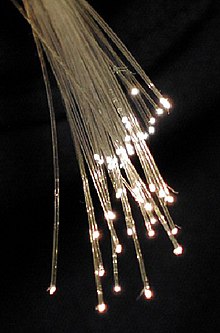
Something I had no idea about was using fibre optics as sensors, which given my use of sensors in much of my work is something I'm going to be looking at, I had a really good chat with Michal Zubel, who as one strand of his research is working on some low budget implementations of sensor read back using webcams and DIY spectrometers (more info on spectrometers can be found at public lab )
The theory behind it is that they can etch grating patterns inside a piece of fibre, both glass and polymer, and when you shine light down the cable, the grating patterns will reflect specific colours of light depending on the spacing of the grating, the clever part is, that if the fibre is distorted the spacing of the grating changes and the colour of the light that is reflected changes as well. You can add different gratings in different positions down the length of the cable and so get multiple sensors in 1 fibre optic. Given that the core of a fibre is 8 µm in diameter, you need some serious kit to create the gratings, but I believe there are commercial suppliers.
I'm not sure if I will investigate this technique directly, as I have also started thinking about using fibres 'coupled' to a ccd of a camera and seeing if I can detect light intensity changes down the length of the fibre, this might make it possible to make a interactive 70's lamp out of a bundle of fibres for example, or something, more convoluted of course!
I've just made a c4d xpresso node so that you can set angle of view from lens ratio, using user data, and also so you can view lens ratio from a camera as user data, useful for designing projections.
Currently doesn't use the lens offset for moving the light that shows your projection cone. Any ideas on how to implement this would be greatly appreciated!
http://www.colour-burst.com/Downloads/ProjectorLensRatio.c4d
I've been missing datamosh and glitch quartz composer plugins that I used to use in VDMX, as I've been using Avenue more recently, until I thought about using syphon as an effect loop.
I presume this might work in Modul8 too, but don't have it to check, in Avenue, you can assign a syphon plugin to the mix or a layer, this comes pre-fade so the layer doesn't actually have to be visible, merely active in a layer, you can then use a quartz composer clip on another layer (if you want to effect the mix, trigger a syphon fx as a clip effect in to a layer, and use the fx return on a layer above it.) Hey presto quartz composer fx in Avenue!
Here are the qtz files, they're setup for Avenue is you want to use them in another app, edit the quartz patch to point to the app you use. You will also need the plugins themselves from Bangnoise and V002
